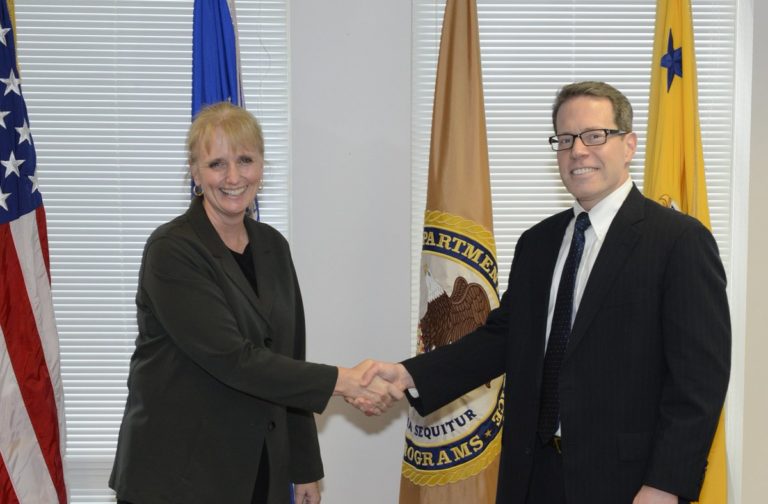Editor’s Note:
In the story below, reporter John Kelly writes that sources inside the U.S. Department of Justice have revealed that the DOJ intends to make crippling cuts to its Office of Juvenile Justice and Delinquency Prevention, or OJJDP, the government agency that—as its mission statement declares—“provides national leadership, coordination, and resources to prevent and respond to juvenile delinquency and victimization.”
At the moment, it isn’t at all clear if there is anyone in the DOJ who has ability or willingness to try to protect the nation’s small but very active and essential juvenile justice agency from such drastic reductions.
When, in January, former Arkansas prosecutor Caren Harp was sworn in as the head of OJJDP, youth advocates kept their fingers crossed that the selection of Harp was not akin to some other appointments made by the Trump administration, which resulted in heads of certain agencies turning out to be opposed to those agencies’ fundamental raison d’être.
With Harp, however, a number of early signs seemed cheering. It helped that her resume revealed her to be a bright and very experienced professional with a strong and long-term interest in juvenile justice.
Yet, at the same time, there have been a few flags on the field.
Directly prior to her appointment, she was for six years Associate Professor at the Jerry Falwell-founded Liberty University School of Law, where Harp’s writings demonstrate her interest in youth justice, but also show her very clear prosecutorial leanings on the topic.
Harp has also worked as a public defender, but only for three of her 23 years as a trial lawyer, and her writings suggest that her personal sentiments skew firmly toward the prosecutorial side of things.
One example is a 2016 report written by Harp for National Juvenile Justice Prosecution Center, in which she notes that early juvenile courts “made use of the ‘best interests of the child’ theory to guide their decision-making.”
A far better metric, Harp wrote, is for juvenile court systems to focus on “three goals: community safety, offender accountability, and competency development in offenders.”
Certainly, all three are worthy goals, but as the central goals in the juvenile system, critics point out that they have too often resulted more in the way of punishment than rehabilitation, and fail to take into account the underlying conditions, trauma and other severe challenges that often lead a kid into the justice system.
In that same report, Harp asserted the claim that only prosecutors should decide if a young person should be tried as a juvenile or as an adult.
In California, that point of view was enshrined in law 18 years ago in the form of Prop 21, which resulted in a flood of dramatically excessive sentences for kids, many of which could have been avoided had judges been making the decisions, rather than prosecutors, with their obvious conflicts of interest. (In November 2016, Prop. 57 returned the filing decision to judges, and took it away from prosecutors.)
In a juvenile justice conference in March held in San Diego, Harp expressed more of her views on juvenile justice, some of which gave youth advocates the jitters, such as her contention that the system was, at the moment, leaning too far in the direction of “therapeutic intervention.”
She has also been very critical of the use of neuroimaging to inform juvenile justice, although advances in neuroscience have changed legal responses to juvenile offending all the way to the U.S. Supreme Court.
Yet in other ways, Harp has shown very strong juvenile reformist instincts. For instance, in the same May 2017 Op-Ed she wrote for the Juvenile Justice Information Exchange, in which she questioned the worth of neuroimaging in the justice world, she also wrote that while “incarcerating youth may solve a crime problem in the short term,” it does not “with rare exception, deter future offending or enhance public safety in the long run. To the contrary, it typically makes everyone less safe.”
Some of the “most successful interventions with youth to reduce reoffending involve community-based diversion programs,” Harp said.
“Creating safe, age-appropriate environments for youth to accept responsibility for the harm they’ve done to victims and communities, without the onerous consequences of conviction or adjudication, is the first, best option for most youthful offenders.”
No argument with that.
Prior to Harp’s appointment, Attorney General Jeff Sessions and company was leaning in a decidedly counter-reformist direction when it came to juvenile justice. The DOJ went so far as to issue a directive on the subject of what words and phrases those working in the OJJDP—now Harps agency—should stop using, and what they should say instead, according to internal documents obtained by the Crime Report in October 2017.
Some of the items on the list that employees were “told to avoid talking about,” wrote TCR’s Ted guest, were “underserved youth” which one should instead refer to as “all youth.”
Additionally, the new administration did not want to call crime problems a “public health issue” or “public health concern.”
The phrase “overrepresentation of minorities (in the juvenile justice system)” was similarly embargoed.
Finally, those who worked in the agency, Gest writes, were advised to “avoid ‘reform (in the context of juvenile justice)’” altogether, “and instead use ‘improvement (or similar rewording).’”
This brings us to the point of John Kelly’s informative report below.
So will Caren Harp work to safeguard the crucial work of agency she now oversees from the justice reform-phobic instincts of her bosses? And if so, can she have a real effect?
On these questions, we must wait and see.
In the meantime, for the on-the-ground details regarding the impact of such cutbacks…read on.
The Real Cost of the DOJ’s Proposed Slashing of the OJJDP
by John Kelly
The Trump Administration plans to cut thousands of Department of Justice positions, which may mean a 25 percent (or more) culling of the already tiny 60-person federal agency focused on juvenile justice, according to several sources at the department or with connections to the matter.
News of these cuts comes as advocates are working feverishly to hammer through a reauthorization of the Juvenile Justice and Delinquency Prevention Act (JJDPA), a 44-year-old law that trades federal grants to states for compliance with basic juvenile justice standards.
“Cuts of this size are alarming, given the amount of work and content expertise necessary to properly administer the duties of the OJJDP office,” said Marcy Mistrett, CEO of the Campaign for Youth Justice, referring to the DOJ’s Office of Juvenile Justice and Delinquency Prevention, “It is also inconsistent with the direction of Congress who has authorized higher levels for the program given its imminent reauthorization.”
The Justice Department aims to make the cuts over the next 18 months through attrition, relying on retirements and early retirement buyouts, sources say. If it comes to layoffs, the likely scenario will be a “last in-first out” policy.
The Office of Justice Programs (OJP) is the Justice Department’s primary liaison with state and local law enforcement agencies, providing large blocks of federal funds for new equipment and hiring new officers and collecting crime-related data.
The Office of Juvenile Justice and Delinquency Prevention, one of the six agencies within OJP, oversees funds related to juvenile justice, mentoring, and efforts to help missing and exploited children.
At the heart of the agency is compliance with the JJDPA, which was passed in 1974 and lays out four core standards for juvenile justice practices:
- Not locking up youth for committing status offenses, crimes like truancy that would not be a crime for an adult.
- Removal of juvenile offenders from adult jails and prisons, with very limited exceptions.
- In those very limited exceptions, sight and sound separation of juveniles from adults in facilities.
- Making efforts to research, identify and address disproportional minority contact (DMC) in the juvenile justice system.
States receive a formula grant for compliance with those standards, and face a 20 percent cut to the grant for each part it does not comply with.
The push to reauthorize takes on new meaning with the planned staffing cuts. Some advocates fear that without new legislation, JJDPA compliance will not be a priority in any shuffling of staff.
One advocate said that the word out of OJJDP was that the cuts would prompt the agency to “greatly loosen enforcement” of JJPDA compliance, especially around the disproportionate minority contact requirement. [The Obama administration updated several JJPDA standards shortly before leaving office, but did not update DMC].
The biggest impact of the cuts would be a gravitation away from managing grants and toward just monitoring them, said one OJJDP employee, on the condition of anonymity. It is a subtle but important difference between working with the programs and departments receiving federal funds, and simply checking paperwork submitted by them.
“If we got a mentoring grantee [who’s supposed to] serve 200 youths over three years, and they’ve only got 23 after a year, we can work with them,” the employee said, by way of example. “Do they need a van service to transport kids? If we can’t get into the weeds with them, they may never get to 200.”
The JJPDA has not been reauthorized in more than 15 years, despite repeated bipartisan efforts in Congress to pass an update. Both chambers have passed a bill in the previous two calendar years, but final passage has been stymied by the holdout of one member: Sen. Tom Cotton (R-Ark.), who opposes the inclusion of a gradual phasing out of a loophole that enables the detention of status offenders who violate court orders.
Both chambers have reportedly agreed to scuttle the phaseout to accommodate Cotton, but the bill has yet to proceed without that provision.
This story originally appeared in the Chronicle of Social Change where John Kelly is the senior editor.
The Chronicle of Social Change is a national news outlet that covers issues affecting vulnerable children, youth and their families. Sign up for their newsletter or follow The Chronicle of Social Change on Facebook or Twitter.



